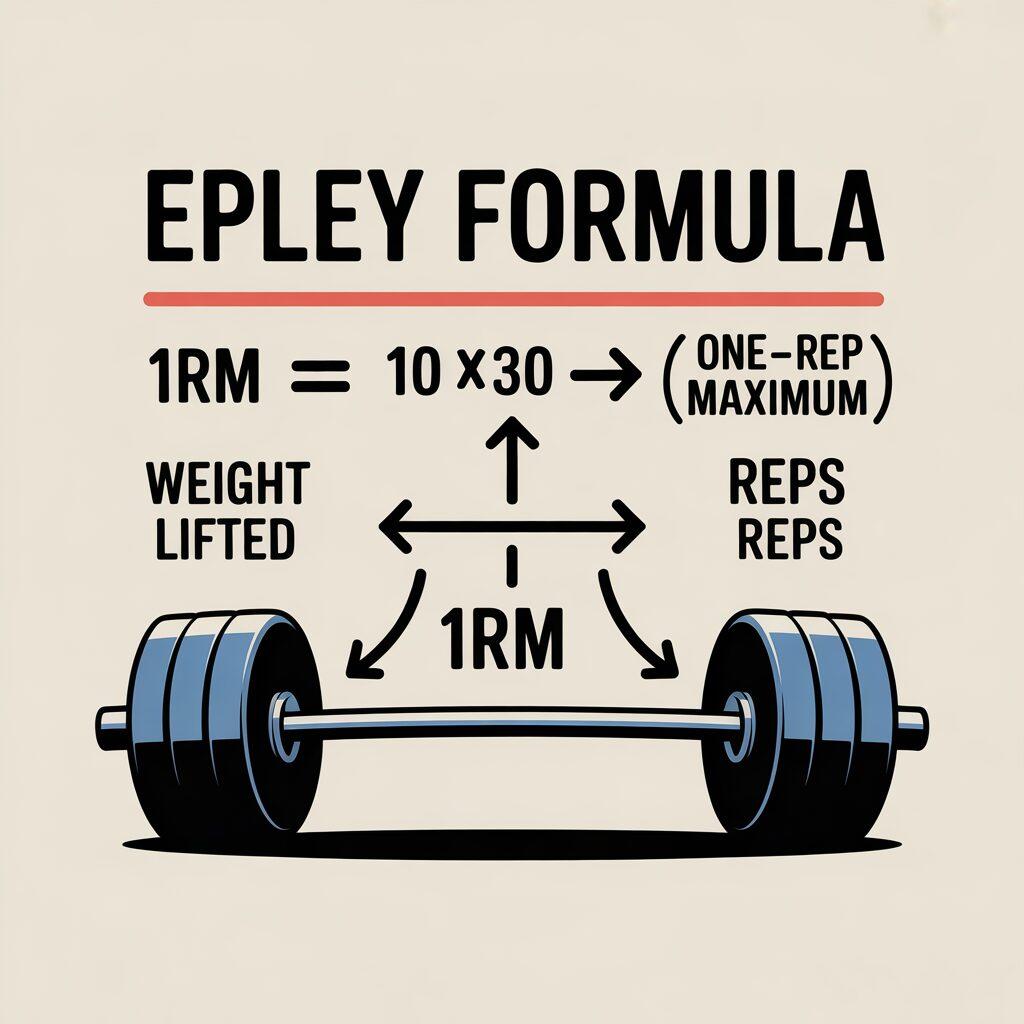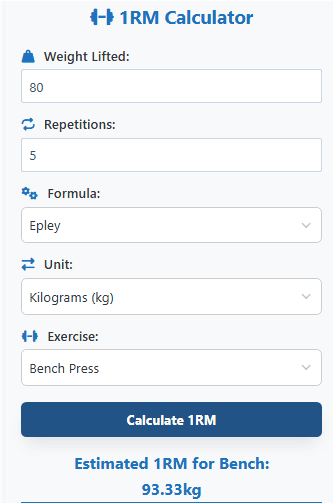For anyone serious about strength training, the concept of a “one-repetition maximum” (1RM) is incredibly important. It represents the heaviest weight an individual can lift for a single, successful repetition of a given exercise. Knowing your 1RM is like having a compass for your fitness journey. It helps you accurately gauge your current strength, track progress, and design effective training programs. But directly testing your 1RM can be risky, demanding, and often unnecessary. This is where the Epley formula comes in.
The Epley formula is a widely recognized and simple method used to estimate your 1RM without having to perform a true maximal lift. It allows you to work with submaximal weights and repetitions, significantly reducing the risk of injury and overtraining. This formula is a powerful tool for athletes, coaches, and everyday fitness enthusiasts alike, offering a practical and safe way to understand your strength potential and drive progressive overload.
What is the Epley Formula, and Why Does it Matter?
At its core, the Epley formula provides a mathematical estimation of your 1RM. It’s a predictive model that uses the weight you can lift for a certain number of repetitions to calculate what your absolute maximum lift would be. This ingenious method was developed by Boyd Epley, a legendary strength coach, and has since become a cornerstone in resistance training programming.
Why is understanding and utilizing the Epley formula so important? Imagine trying to navigate without a map. That’s what training without knowing your 1RM can feel like. The Epley formula offers several key benefits:
- Safety First: Attempting a true 1RM can be taxing on your central nervous system and carries an inherent risk of injury, especially if proper form is compromised. The Epley formula allows you to estimate this crucial metric using a lighter, safer weight.
- Effective Program Design: Many strength training programs are built around percentages of your 1RM. Knowing this number, even an estimation, allows you to accurately set your working sets and reps for hypertrophy (muscle growth), strength, or power.
- Tracking Progress: Over time, as your strength increases, the Epley formula helps you quantify those gains. You can re-evaluate your estimated 1RM periodically to see how much stronger you’ve become.
- Avoiding Overtraining: By providing a clear framework for your training loads, the formula helps prevent you from consistently pushing too hard and risking burnout.
- Goal Setting: Clear, measurable goals are vital for motivation. Using the Epley formula to estimate your 1RM allows you to set ambitious yet realistic strength targets.
The Science Behind the Epley Formula: A Glimpse into its Mechanism
The Epley formula, like other 1RM prediction equations, is based on the inverse relationship between the weight lifted and the number of repetitions that can be performed. Simply put, the heavier the weight, the fewer repetitions you can complete. The formula seeks to quantify this relationship.
The commonly used version of the Epley formula is:
1RM=Weight Lifted×(1+(Reps/30))
Let’s break down what each part means:
- 1RM: This is the estimated one-repetition maximum you are trying to find.
- Weight Lifted: This is the actual weight you successfully lifted during your submaximal test set.
- Reps: This is the number of repetitions you completed with the “Weight Lifted.” The formula is generally most accurate when using 2-10 repetitions. Trying to estimate a 1RM from a very high number of reps (e.g., 20 or more) tends to be less precise due to the increased influence of muscular endurance.
The “1 + (Reps / 30)” component is the unique factor derived from empirical observations. It acts as a multiplier that scales your submaximal lift to an estimated maximal lift. The underlying principle is that for every additional repetition you can perform beyond one, the weight is proportionally lighter than your true 1RM.

While the Epley formula is widely accepted, it’s important to remember that it’s an estimation, not an exact measurement. Individual physiological differences, such as muscle fiber composition (fast-twitch vs. slow-twitch), training experience, and specific exercise mechanics, can influence its accuracy. However, for most individuals and common strength exercises, it provides a highly practical and reliable estimate.
How to Calculate Your 1RM Using the Epley Formula: A Step-by-Step Guide
Calculating your 1RM using the Epley formula is straightforward. Here’s how you can do it safely and effectively:
- Choose an Exercise: Select the exercise for which you want to estimate your 1RM. This could be bench press, squat, deadlift, overhead press, or any other compound lift.
- Proper Warm-Up is Crucial: Never jump straight into heavy lifting. A thorough warm-up is essential to prepare your muscles, joints, and nervous system. Start with light cardio, followed by dynamic stretches, and then several sets of the chosen exercise with progressively heavier weights and fewer reps. For example, if you’re aiming to lift 100 kg for 5 reps, your warm-up might look like:
- Empty bar x 10-15 reps
- 40% of target weight x 8-10 reps
- 60% of target weight x 5-6 reps
- 80% of target weight x 2-3 reps
- Perform a Submaximal Set: Choose a weight that you can lift for 2-10 repetitions with good form. This should be a challenging weight, but not an all-out maximal effort that compromises your technique. Aim to reach near muscular failure, but stop before your form breaks down.
- Record Weight and Reps: Carefully note the exact weight you lifted and the number of clean, controlled repetitions you completed.
- Apply the Epley Formula: Plug your recorded weight and repetitions into the formula: 1RM=Weight Lifted×(1+(Reps/30))
Example:
Let’s say you perform a bench press with 80 kg and successfully complete 6 repetitions.
1RM=80 kg×(1+(6/30)) 1RM=80 kg×(1+0.2) 1RM=80 kg×1.2 1RM=96 kg
So, your estimated 1RM for the bench press, according to the Epley formula, would be 96 kg.
Advantages of Using the Epley Formula in Your Training
The Epley formula offers numerous advantages for anyone engaged in strength training, from beginners to seasoned lifters.
- Reduced Injury Risk: As mentioned, avoiding true maximal attempts significantly lowers the risk of muscle strains, tears, and joint injuries. This is especially important for individuals who might not have a spotter or are new to heavy lifting.
- Minimizes Central Nervous System (CNS) Fatigue: Maximal lifts are incredibly demanding on the CNS, requiring longer recovery periods. By estimating your 1RM, you can still train effectively without constantly overtaxing your nervous system, allowing for more consistent training sessions.
- Time Efficiency: Directly testing your 1RM can be a lengthy process, often requiring multiple heavy sets. The Epley formula provides a quick and efficient way to get a solid estimate with fewer sets.
- Accessibility: You don’t need specialized equipment or a highly experienced spotter to use this formula. A standard gym setup and basic knowledge of your lifting capabilities are sufficient.
- Versatility Across Exercises: The Epley formula can be applied to virtually any resistance exercise where a repetition maximum can be performed. This makes it a versatile tool for full-body strength assessment.
- Basis for Progressive Overload: The fundamental principle of strength adaptation is progressive overload – gradually increasing the demands on your muscles. Your estimated 1RM gives you a benchmark. If your 1RM is 100 kg, and a program calls for 75% of your 1RM, you know to lift 75 kg. As your estimated 1RM rises, so too will your working weights, ensuring continuous progress.
Limitations and Considerations When Using the Epley Formula
While incredibly useful, the Epley formula, like any estimation tool, has its limitations. Being aware of these can help you use it more effectively.
- Accuracy Varies with Rep Range: The formula is generally most accurate for repetition ranges between 2 and 10. Using very low reps (e.g., 1-2 reps) might be closer to a true 1RM test, but still an estimate. Using very high reps (e.g., 12-15+ reps) can lead to less accurate predictions because endurance factors become more dominant than pure strength.
- Individual Variability: Not everyone responds identically to training or fits perfectly into a general formula. Factors like genetics, training history, muscle fiber type distribution, and even daily fatigue levels can influence the accuracy of the prediction. Some individuals are naturally better at lower reps, while others excel at higher reps, which can skew the estimation.
- Exercise Specificity: While versatile, the formula might perform differently across various exercises. For highly technical lifts like the Olympic lifts (snatch, clean and jerk), where technique plays a huge role, the formula might be less reliable than for simpler, strength-focused movements like squats or deadlifts.
- Form Matters: The accuracy of your input is paramount. If your form breaks down during your submaximal set, the weight and reps you record will not be a true reflection of your strength, leading to an inaccurate 1RM estimation. Always prioritize strict form.
- Not a Substitute for True 1RM Testing (in some cases): For competitive powerlifters or athletes needing precise 1RM numbers for specific events, periodic true 1RM testing under competition-like conditions may still be necessary. The Epley formula is best used as a training tool rather than a definitive competitive benchmark.
Common Mistakes to Avoid When Applying the Epley Formula
Even with its simplicity, common pitfalls can lead to inaccurate results or hinder your progress when using the Epley formula.
- Rushing the Warm-Up: An insufficient warm-up can lead to poor performance on your submaximal set, resulting in an underestimate of your true strength. It also increases injury risk. Take your time to properly prepare your body.
- Using Too Many or Too Few Reps: As discussed, sticking to the 2-10 rep range generally yields the most reliable results. Attempting to estimate your 1RM from a set of 15+ reps may overemphasize endurance and provide an overly optimistic or pessimistic estimate.
- Compromising Form: Sacrificing proper technique to squeeze out extra reps or lift heavier weight will give you a misleading 1RM. Always prioritize form over the numbers. If your form starts to break, terminate the set.
- Not Resting Enough Between Sets (Warm-up and Test Set): Adequate rest ensures your muscles are fresh for the working set, allowing for an accurate reflection of your strength. For the submaximal test set, take 3-5 minutes of rest after your warm-up.
- Ignoring Daily Fluctuations: Your strength can vary day to day based on sleep, nutrition, stress, and recovery. Don’t be discouraged if your estimated 1RM is slightly lower on a particular day. It’s an average trend that matters.
- Becoming Over-Reliant on the Formula: While useful, the Epley formula is a tool, not the sole determinant of your training. Listen to your body, adjust your training as needed, and consider other metrics like Rate of Perceived Exertion (RPE) or Reps in Reserve (RIR) to fine-tune your workouts.
Beyond the Calculation: Integrating the Epley Formula into Your Training Program
Knowing your estimated 1RM through the Epley formula is just the first step. The real magic happens when you integrate this knowledge into your training methodology.
- Periodization: Many strength training programs use periodization, a systematic approach to training that varies intensity and volume over time. Linear periodization, for example, might start with higher reps and lower percentages of 1RM, gradually progressing to lower reps and higher percentages as a competition or strength peak approaches. The Epley formula provides the baseline for setting these percentages.
- Setting Workout Intensity: For muscle hypertrophy, programs often suggest working with weights around 65-85% of your 1RM for 6-12 repetitions. For pure strength, you might focus on 80-95% of your 1RM for 1-5 repetitions. Your Epley formula estimate allows you to select the appropriate weight for these target intensities.
- Progressive Overload: Once you have your estimated 1RM, you can plan your progressive overload. Over time, you’ll aim to increase the weight, reps, or sets. For example, if you’re training with 75% of your 1RM, and after a few weeks, your estimated 1RM increases, you can then proportionally increase your 75% working weight.
- Deloading Strategies: Understanding your 1RM can also inform deloading, which involves temporarily reducing training volume or intensity to allow for recovery and supercompensation. By knowing your typical working percentages, you can easily calculate appropriate deload weights.
- Injury Prevention and Management: If you’re recovering from an injury or just starting, using the Epley formula allows you to work with lighter, safer weights while still having a quantifiable measure of your strength and progress. This helps build a strong foundation without overstressing vulnerable areas.
The Epley Formula and Online Calculators: A Modern Approach
In today’s digital age, you don’t even need to do the math yourself. Many excellent online 1RM calculators utilize the Epley formula and other variations to provide instant estimations. One such reliable tool is the 1 Rep Max Calculator.

Using an online calculator is incredibly convenient. You simply input the weight you lifted and the number of repetitions, and the calculator instantly provides your estimated 1RM. This saves time and minimizes the chance of calculation errors. When using such tools, ensure you understand which formula they are using, as some calculators offer multiple options (e.g., Brzycki, Lombardi, etc.). For consistency in tracking your progress, it’s best to stick to one formula.
Frequently Asked Questions about the Epley Formula
Understanding the Epley formula often leads to common questions. Here are some answers to help clarify its use and implications:
Is the Epley formula accurate for all exercises?
While highly versatile, its accuracy can vary. It tends to be most accurate for compound lifts like squats, bench press, and deadlifts. For highly technical movements or isolation exercises, it might be slightly less precise, but still provides a valuable estimate.
How often should I re-calculate my 1RM using the Epley formula?
This depends on your training goals and program. For most individuals, re-calculating every 4-8 weeks is a good general guideline. If you’re in a specific strength phase or notice significant progress, you might do it more frequently.
Can I use the Epley formula if I’m a beginner?
Absolutely! The Epley formula is particularly useful for beginners as it allows them to estimate their 1RM safely without the risks associated with maximal lifting attempts. It helps them set appropriate weights for their initial training.
Does the Epley formula account for individual differences?
The basic formula provides a general estimation. While it doesn’t individually adjust for factors like muscle fiber type or specific training history, its widespread use indicates its general applicability. For highly precise, individualized data, advanced strength testing or working with a coach might be beneficial.
What if my estimated 1RM seems much higher or lower than I expected?
Several factors could contribute. If it’s surprisingly high, you might have performed more reps than you truly could with perfect form, or you’re naturally very efficient at higher reps. If it’s surprisingly low, you might have ended your set too early, or perhaps you excel more at single maximal lifts than higher rep work. Always re-evaluate your form and effort.
Unlocking Your True Strength Potential
The Epley formula is more than just a mathematical equation; it’s a gateway to more intelligent, safer, and ultimately more effective strength training. By understanding how to apply this simple yet powerful tool, you gain invaluable insight into your current strength levels, enabling you to design better programs, track your progress with precision, and systematically pursue your strength goals. Remember, consistency, proper form, and listening to your body remain paramount. With the Epley formula in your arsenal, you are well-equipped to unleash your incredible strength potential and achieve lasting fitness success.






